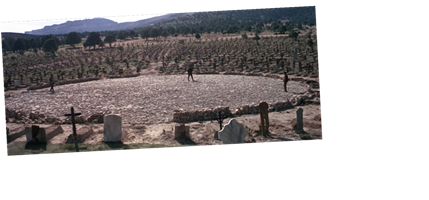With readers turning to their home viewing options more than ever, this daily feature provides one new movie each day worth checking out on a major streaming platform.
Quentin Tarantino’s favorite cut in movie history arrives two hours and 45 minutes into Sergio Leone’s 1966 Spaghetti Western “The Good, the Bad and the Ugly.” Three gunslingers have been competing to find buried Confederate gold and their search climaxes in a Mexican standoff inside a bullring at Sad Hill Cemetery. Blondie (Clint Eastwood) writes the name of a tomb that houses the gold on the bottom of a rock and places it at the center of the bullring. Ennio Morricone’s score sets the tension as Blondie, Angel Eyes (Lee Van Cleef), and Tuco (Eli Wallach) get into formation and prepare to draw their guns. When the music peaks, Leone cuts to a wide shot of the Mexican standoff in full view.
“That’s easy,” Tarantino told Empire magazine when asked about his favorite shot in the film. “During the three-way bullring showdown at the end, the music builds to the giant orchestra crescendo, and when it gets to the first big explosion of the theme there’s a wide shot of the bullring. After you’ve seen all the little shots of the guys getting into position, you suddenly see the whole wideness of the bullring and all the graves around them. It’s my favorite shot in the movie, but I’ll even say it’s my favorite cut in the history of movies.”
Tarantino has often turned to Leone for inspiration throughout his career. The iconic door shoot from “Once Upon a Time in the West” (1968) is restaged at the end of the opening scene in “Inlgourious Basterds” (2009). Tarantino even remixes his beloved “The Good, the Bad and the Ugly” cut in “Kill Bill.” During the climactic “Vol. 1” showdown between The Bride (Uma Thurman) and O-Ren Ishii (Lucy Liu), Tarantino cuts several times from close-ups of their weapons and faces to a wide shot of their duel in a snowy Japanese garden. For both Leone and Tarantino, the cuts take the intensity building between characters and explodes it on a grand scale. The life-or-death stakes of these confrontations are raised tenfold by the cut as the characters in wide shots become chess pieces and the expansive landscape around them serves as an arena for their next deadly moves.
While Tarantino has directly lifted from the cut, the relationship between his filmography and Leone’s climactic edit runs far grander. Leone’s cut shifts from the micro-specificity of his characters actions to the macro view of their confrontation, and the cut’s power is increased by the obsessive, meticulous approach that Leone applies to the space. The filmmaker spends nearly three minutes studying his characters’ every move as they eye the other down and prepare to draw. The intensity is escalated by close-ups that draw tighter on each character’s gaze with every cut. The tension is drawn out to such an unbearable — even comical — degree that the cut to the wide shot arrives like a lightening bolt. It’s not so much a break in tension but a change in the perspective of that tension, as the sudden bird’s eye view of the scene makes it clear that death is inevitable.
Leone’s shift from the micro to the macro perspective has become the essence of Tarantino’s storytelling mastery. Few directors’ films work on such a painstaking scene-to-scene basis. The majority of Tarantino’s films are comprised of extended set pieces that have the drawn-out pacing of Blondie, Angel Eyes, and Tuco preparing to draw. (See the Hans Landa opening or the speakeasy card game in “Inglourious Basterds” for one prominent example.) When Tarantino’s scripts shift to a larger scale, the end result can have a dazzling effect: It happens when Butch (Bruce Willis) kills Vincent (John Travolta) midway through “Pulp Fiction” and the viewer is forced to reckon with the new reality of Tarantino’s nonlinear storytelling. And it happens in “Once Upon a Time in Holllywood,” when Sharon Tate (Margot Robbie) welcomes Rick Dalton (Leonardo DiCaprio) to her home and the purpose of Tarantino’s revisionist history is revealed not as wish fulfillment but as a coping mechanism to mourn a lost generation.
It makes sense that Tarantino considers Leone’s Mexican standoff cut in “The Good, the Bad and the Ugly” to be the best in cinema history because he’s built his storytelling skills on a similar shift in perspective. In Tarantino’s bullring, his draw knocks you out every time.
“The Good, the Bad and the Ugly” is available on a variety of streaming on Netflix.
Source: Read Full Article
